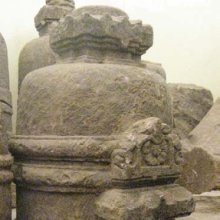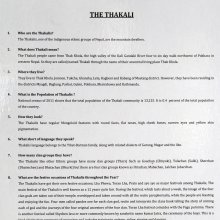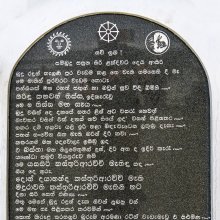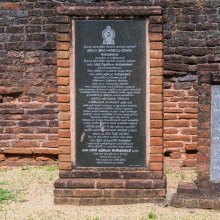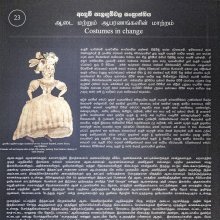Caya, Cayā, Cāyā: 22 definitions
Introduction:
Caya means something in Buddhism, Pali, Hinduism, Sanskrit, Marathi, Jainism, Prakrit, Hindi, biology, Tamil. If you want to know the exact meaning, history, etymology or English translation of this term then check out the descriptions on this page. Add your comment or reference to a book if you want to contribute to this summary article.
Alternative spellings of this word include Chaya.
Images (photo gallery)
In Hinduism
Ayurveda (science of life)
Agriculture (Krishi) and Vrikshayurveda (study of Plant life)
Source: Shodhganga: Drumavichitrikarnam—Plant mutagenesis in ancient IndiaCaya (चय) refers to “bunches (of flowers)”, which were created using certain bio-organical recipes for plant mutagenesis, according to the Vṛkṣāyurveda by Sūrapāla (1000 CE): an encyclopedic work dealing with the study of trees and the principles of ancient Indian agriculture.—Accordingly, “If bulbs of various species of Nymphaea are uprooted tied together firmly with threads, smeared with melted butter and honey and then planted they produce those respective species in bunches (puṣpa-caya) (on a single creeper) [coptaṃ tathā tathā puṣpacayaṃ dadhāti]. Similarly several wonders of transformation can be worked out by tying together the stems of Nerium indicum and those of various species of Punica granatum”.
Unclassified Ayurveda definitions
Source: gurumukhi.ru: Ayurveda glossary of termsCaya (चय):—[cayaḥ] Accumulation

Āyurveda (आयुर्वेद, ayurveda) is a branch of Indian science dealing with medicine, herbalism, taxology, anatomy, surgery, alchemy and related topics. Traditional practice of Āyurveda in ancient India dates back to at least the first millenium BC. Literature is commonly written in Sanskrit using various poetic metres.
Shaktism (Shakta philosophy)
Source: Google Books: ManthanabhairavatantramCaya (चय) refers to the “mass (of red and beautiful rays)”, according to the Manthānabhairavatantra, a vast sprawling work that belongs to a corpus of Tantric texts concerned with the worship of the goddess Kubjikā.—Accordingly, “[...] Her form is the Triangle and her plane unlimited ability. She is enflamed by the burning Point. Causing (nectar) to flow, she floods the entire plane of the universe with dense currents of nectar. Active in the utterance (of mantra that takes place) in the centre, she pervades all things with the mass of (her) red and beautiful rays (aruṇaruci-caya). [...]”.

Shakta (शाक्त, śākta) or Shaktism (śāktism) represents a tradition of Hinduism where the Goddess (Devi) is revered and worshipped. Shakta literature includes a range of scriptures, including various Agamas and Tantras, although its roots may be traced back to the Vedas.
In Buddhism
Theravada (major branch of Buddhism)
Source: Buddhist Information: A Survey of Paramattha DhammasCaya means heaping, heaping up.
Theravāda is a major branch of Buddhism having the the Pali canon (tipitaka) as their canonical literature, which includes the vinaya-pitaka (monastic rules), the sutta-pitaka (Buddhist sermons) and the abhidhamma-pitaka (philosophy and psychology).
Biology (plants and animals)
Source: Google Books: CRC World Dictionary (Regional names)Caya in India is the name of a plant defined with Clerodendrum phlomidis in various botanical sources. This page contains potential references in Ayurveda, modern medicine, and other folk traditions or local practices It has the synonym Volkameria multiflora Burm.f. (among others).
Example references for further research on medicinal uses or toxicity (see latin names for full list):
· Flora Indica (1768)
· Hortus Suburbanus Calcuttensis (1845)
· Supplementum Plantarum (1782)
· Edinb. Phil. Journ. (1824)
· Prodr. (DC.) (1836)
· Cytologia (1983)
If you are looking for specific details regarding Caya, for example health benefits, extract dosage, diet and recipes, side effects, chemical composition, pregnancy safety, have a look at these references.

This sections includes definitions from the five kingdoms of living things: Animals, Plants, Fungi, Protists and Monera. It will include both the official binomial nomenclature (scientific names usually in Latin) as well as regional spellings and variants.
Languages of India and abroad
Pali-English dictionary
Source: BuddhaSasana: Concise Pali-English Dictionarycaya : (m.) piling; heaping; a mass.
Source: Sutta: The Pali Text Society's Pali-English DictionaryCaya, (from cināti) piling, heaping; collection, mass Vin. II, 117; DhsA. 44; in building: a layer Vin. II, 122, 152. As —° one who heaps up, a collector, hoarder M. I, 452 (nikkha°, khetta°, etc.). See also ā°, apa°, upa°. (Page 262)

Pali is the language of the Tipiṭaka, which is the sacred canon of Theravāda Buddhism and contains much of the Buddha’s speech. Closeley related to Sanskrit, both languages are used interchangeably between religions.
Marathi-English dictionary
Source: DDSA: The Molesworth Marathi and English Dictionarycaya (चय).—m S Collecting or a collection; assembling or an assemblage. Ex. of comp. apacaya, sañcaya, samu- ccaya. 2 A. or G. progression.
Marathi is an Indo-European language having over 70 million native speakers people in (predominantly) Maharashtra India. Marathi, like many other Indo-Aryan languages, evolved from early forms of Prakrit, which itself is a subset of Sanskrit, one of the most ancient languages of the world.
Sanskrit dictionary
Source: DDSA: The practical Sanskrit-English dictionaryCaya (चय).—[ci-ac]
1) An assemblage; collection, multitude, heap, mass; चयस्त्विषामित्यवधारितं पुरा (cayastviṣāmityavadhāritaṃ purā) Śiśupālavadha 1.3; मृदां चयः (mṛdāṃ cayaḥ) Uttararāmacarita 2.7 a lump of clay; कचानां चयः (kacānāṃ cayaḥ) Bhartṛhari 1.5 a braid of hair; so चमरीचयः (camarīcayaḥ) Śiśupālavadha 4.6; कुसुमचय, तुषारचय (kusumacaya, tuṣāracaya) &c.
2) A mound of earth raised to form the foundation of a building.
3) A mound of earth raised from the ditch of a fort.
4) A rampart.
5) The gate of a fort.
6) A seat, stool.
7) A pile of buildings, any edifice.
8) Stacked wood.
9) A cover or covering.
1) Arranging or keeping the sacred fire; cf. अग्निचय (agnicaya).
11) The amount by which each term increases, the common increase or difference of the terms (in a progression).
Derivable forms: cayaḥ (चयः).
Source: Cologne Digital Sanskrit Dictionaries: Shabda-Sagara Sanskrit-English DictionaryCaya (चय).—m. (yaḥ) 1. An assemblage, a multitude. 2. A heap, a collection. 3. A mound of earth, raised to form the foundation of a building. 4. A rampart or mound of earth raised from the ditch of a fort. 5. The gate of a fort. 6. Any ediflce. 7. A seat, a stool. 8. A cover, a covering. E. ci to collect, aff. ac.
Source: Cologne Digital Sanskrit Dictionaries: Benfey Sanskrit-English DictionaryCaya (चय).—i. e. ci + a, m. 1. A heap, Mārk. P. 21, 86. 2. A mass, Mahābhārata 3, 16426. 3. A multitude, [Caurapañcāśikā] 34. 4. Arranged fuel, [Harivaṃśa, (ed. Calc.)] 2161. 5. A mound of earth, a rampart, [Rāmāyaṇa] 5, 9, 15.
Source: Cologne Digital Sanskrit Dictionaries: Cappeller Sanskrit-English DictionaryCaya (चय).—1. [masculine] layer, heap, pile, wall; troop, multitude, collection.
--- OR ---
Caya (चय).—2. [adjective] revenging, punishing (—°).
Source: Cologne Digital Sanskrit Dictionaries: Monier-Williams Sanskrit-English Dictionary1) Caya (चय):—a 1. & 2. caya, etc. See √1. & 3. ci.
2) [from ci] 1. caya mfn. ‘collecting’ See vṛtaṃ-
3) [v.s. ...] m. ([iii, 3, 56; Kāśikā-vṛtti]; [gana] vṛṣādi) a mound of earth (raised to form the foundation of a building or raised as a rampart), [Mahābhārata iii, 11699; Harivaṃśa; Rāmāyaṇa; Pañcatantra]
4) [v.s. ...] a cover, covering, [Horace H. Wilson]
5) [v.s. ...] a heap, pile, collection, multitude, assemblage, [Mahābhārata; Harivaṃśa] etc.
6) [v.s. ...] (in med.) accumulation of the humors (cf. saṃ-), [Suśruta]
7) [v.s. ...] the amount by which each term increases, common increase or difference of the terms, [Bījagaṇita] (cf. agni-).
8) [from ci] 2. caya mfn. ifc. ‘revenging’ See ṛṇaṃ-.
Source: Cologne Digital Sanskrit Dictionaries: Yates Sanskrit-English DictionaryCaya (चय):—(yaḥ) 1. m. An assemblage; heap; mound; rampart; fort gate; edifice; seat; cover.
Source: DDSA: Paia-sadda-mahannavo; a comprehensive Prakrit Hindi dictionary (S)Caya (चय) in the Sanskrit language is related to the Prakrit word: Caya.
[Sanskrit to German]
Sanskrit, also spelled संस्कृतम् (saṃskṛtam), is an ancient language of India commonly seen as the grandmother of the Indo-European language family (even English!). Closely allied with Prakrit and Pali, Sanskrit is more exhaustive in both grammar and terms and has the most extensive collection of literature in the world, greatly surpassing its sister-languages Greek and Latin.
Hindi dictionary
Source: DDSA: A practical Hindi-English dictionaryCāya (चाय) [Also spelled chay]:—(nf) tea; ~[ghara] a tea-house, canteen; ~[dānī] a tea-pot; -[pānī] breakfast; tea; tea and snacks, light refreshment; —[para bulānā] to invite for tea.
...
Prakrit-English dictionary
Source: DDSA: Paia-sadda-mahannavo; a comprehensive Prakrit Hindi dictionary1) Caya (चय) in the Prakrit language is related to the Sanskrit word: Tyaj.
2) Caya (चय) also relates to the Sanskrit word: Śak.
3) Caya (चय) also relates to the Sanskrit word: Cyu.
4) Caya (चय) also relates to the Sanskrit word: Caya.
5) Caya (चय) also relates to the Sanskrit word: Caya.
6) Caya (चय) also relates to the Sanskrit word: Cyava.
7) Cāya (चाय) also relates to the Sanskrit word: Tyāga.
Prakrit is an ancient language closely associated with both Pali and Sanskrit. Jain literature is often composed in this language or sub-dialects, such as the Agamas and their commentaries which are written in Ardhamagadhi and Maharashtri Prakrit. The earliest extant texts can be dated to as early as the 4th century BCE although core portions might be older.
Kannada-English dictionary
Source: Alar: Kannada-English corpusCaya (ಚಯ):—
1) [noun] a large number of things, gathered together or considered as a unit; a host; a multitude.
2) [noun] a heap of earth; a mound.
3) [noun] the outer wall fortifying a place.
--- OR ---
Cāya (ಚಾಯ):—
1) [noun] degree of darkness of a colour; a shade.
2) [noun] the state or quality of shining by reflecting light; lustre.
3) [noun] a manner, way of doing something or in which something is done.
4) [noun] the comparative darkness caused by the interception or screening of rays of light from an object, place or area; shadow.
Kannada is a Dravidian language (as opposed to the Indo-European language family) mainly spoken in the southwestern region of India.
Tamil dictionary
Source: DDSA: University of Madras: Tamil LexiconCaya (சய) noun < Jaya. The 28th year of the Jupiter cycle; அறுபதுவருட பலன் ஆண்டுகளுள் இருபத் தெட்டாவது. [arupathuvaruda palan andugalul irupath thettavathu.]
--- OR ---
Cayā (சயா) noun < jayā.
1. Wind-killer. See வாதமடக்கி. (வைத்திய மலையகராதி) [vathamadakki. (vaithiya malaiyagarathi)]
2. Chebulic myrobalan. See கடுக்காய். [kadukkay.] (தைலவருக்கச்சுருக்கம் தைல. [thailavarukkachurukkam thaila.] 125.)
--- OR ---
Cāya (சாய) noun < Urdu chā. Tea; தேயிலை. [theyilai.] Nāñ.
Tamil is an ancient language of India from the Dravidian family spoken by roughly 250 million people mainly in southern India and Sri Lanka.
Nepali dictionary
Source: unoes: Nepali-English Dictionary1) Caya (चय):—n. heap; pile; collection; accumulation;
2) Cāyā (चाया):—n. 1. dandruff; scurf; 2. scab;
Nepali is the primary language of the Nepalese people counting almost 20 million native speakers. The country of Nepal is situated in the Himalaya mountain range to the north of India.
See also (Relevant definitions)
Starts with (+12): Cayaberu, Cayaga, Cayaka, Cayamana, Cayambhatta, Cayaminu, Cayana, Cayanadi, Cayanakarika, Cayanamantra, Cayanamantrapada, Cayanandabila, Cayananta, Cayanapaddhati, Cayanaprashna, Cayanaprayoga, Cayanapuranabhashya, Cayanasavitri, Cayanashatadvayi, Cayanasutra.
Query error!
Full-text (+511): Chaya, Upacaya, Paricaya, Nicaya, Saya, Sancaya, Samshaya, Vishaya, Nishcaya, Vicchaya, Apacaya, Pracaya, Hricchaya, Ashaya, Atishaya, Jalasaya, Avacaya, Vyavasaya, Bileshaya, Uccaya.
Relevant text
Search found 131 books and stories containing Caya, Cāya, Cayā, Cāyā, Chaya, Ci-a, Saaya, Saya, Sayaa; (plurals include: Cayas, Cāyas, Cayās, Cāyās, Chayas, as, Saayas, Sayas, Sayaas). You can also click to the full overview containing English textual excerpts. Below are direct links for the most relevant articles:
Garga Samhita (English) (by Danavir Goswami)
Verse 3.1.4 < [Chapter 1 - The Worship of Śrī Girirāja]
Verse 2.3.5 < [Chapter 3 - Description of the Yamunā’s Arrival]
Verse 4.12.11 < [Chapter 12 - The Story of the Gopīs That In the Holi Festival Displayed Three Transcendental Virtues]
AYU (Journal of Research in Ayurveda)
A critical review of antiquity, authorship and contents of Haramekhala: A medieval work on humanities < [Volume 32 (4); 2011 (Oct-Dec)]
Historical development of basic concepts of Ayurveda from Veda up to Samhita < [Volume 31 (4); 2010 (Oct-Dec)]
Efficacy of Rituharitaki (seasonal adjuvant of Haritaki) on disorders of Varsha Ritu (monsoon) w.s.r. to quality of life: An open labelled randomized controlled clinical trial < [Volume 40 (4); 2019 (Oct-Dec)]
Vastu-shastra (Introduction to Indian architecture) (by D. N. Shukla)
Chapter 6 - The Construction of the Śālās < [Volume 3 - House Architecture]
Chapter 8 - The Pillar and other Members < [Volume 3 - House Architecture]
International Ayurvedic Medical Journal
Role of chaya and prabha to maintain skin color < [2021, Issue 6, June]
Inside review of charakoktha indriya sthana < [2023, Issue 02, February]
A clinical study on the role of medhyarasayana on shayaamutra (enuresis) in children < [2016, Issue V May]
Physician as depicted in Manasollasa (by Sri B. S. Hebballi)
Appendix: Glossary of Selected Sanskrit Words
4. Nidana-pancaka (Pathology or Investigation of Diseases) < [Chapter 4 - Ancient treatises on Indian medicine]
Devi Bhagavata Purana (by Swami Vijñanananda)
Related products
